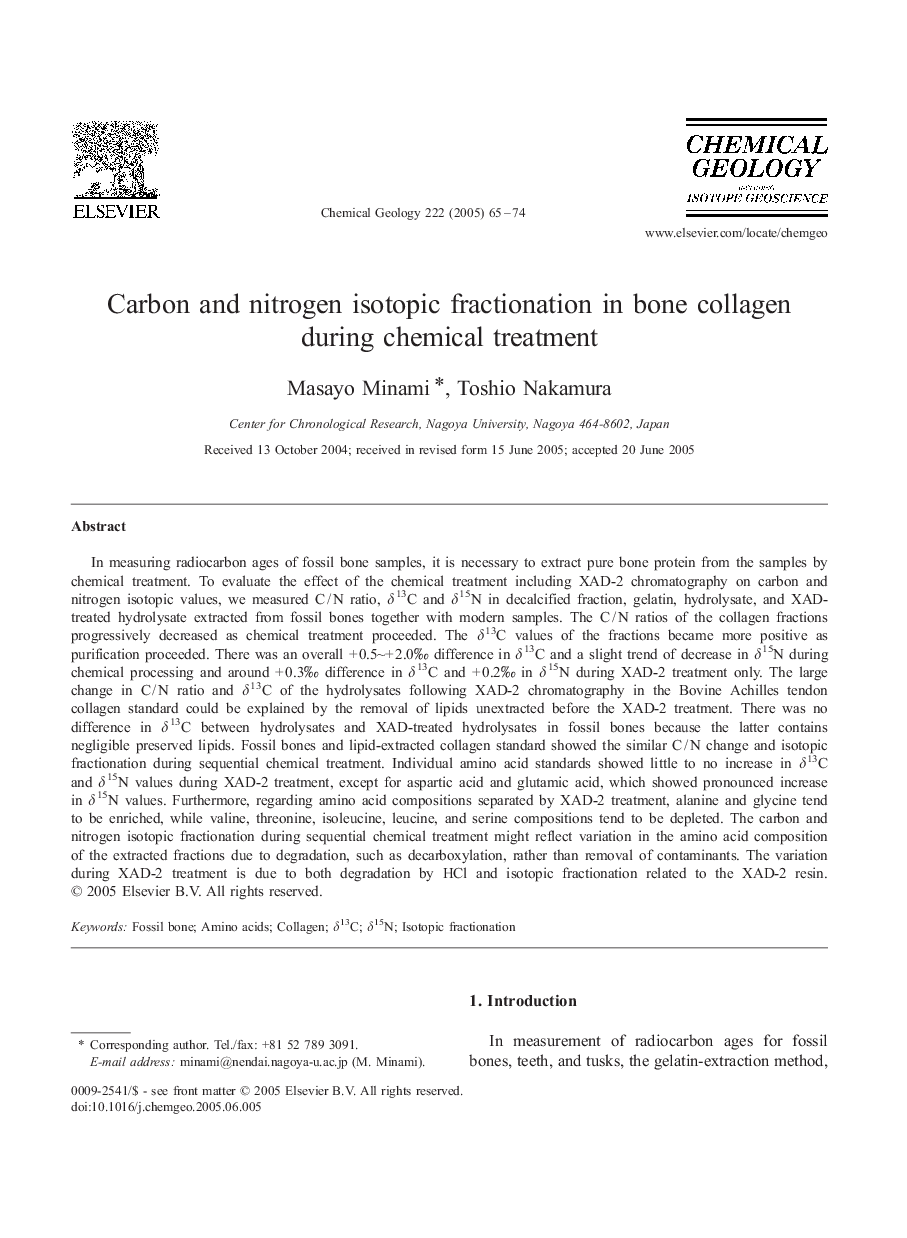| کد مقاله | کد نشریه | سال انتشار | مقاله انگلیسی | نسخه تمام متن |
|---|---|---|---|---|
| 9529172 | 1637781 | 2005 | 10 صفحه PDF | دانلود رایگان |
عنوان انگلیسی مقاله ISI
Carbon and nitrogen isotopic fractionation in bone collagen during chemical treatment
دانلود مقاله + سفارش ترجمه
دانلود مقاله ISI انگلیسی
رایگان برای ایرانیان
کلمات کلیدی
موضوعات مرتبط
مهندسی و علوم پایه
علوم زمین و سیارات
ژئوشیمی و پترولوژی
پیش نمایش صفحه اول مقاله

چکیده انگلیسی
In measuring radiocarbon ages of fossil bone samples, it is necessary to extract pure bone protein from the samples by chemical treatment. To evaluate the effect of the chemical treatment including XAD-2 chromatography on carbon and nitrogen isotopic values, we measured C / N ratio, δ13C and δ15N in decalcified fraction, gelatin, hydrolysate, and XAD-treated hydrolysate extracted from fossil bones together with modern samples. The C / N ratios of the collagen fractions progressively decreased as chemical treatment proceeded. The δ13C values of the fractions became more positive as purification proceeded. There was an overall + 0.5â¼+ 2.0â° difference in δ13C and a slight trend of decrease in δ15N during chemical processing and around + 0.3â° difference in δ13C and + 0.2â° in δ15N during XAD-2 treatment only. The large change in C / N ratio and δ13C of the hydrolysates following XAD-2 chromatography in the Bovine Achilles tendon collagen standard could be explained by the removal of lipids unextracted before the XAD-2 treatment. There was no difference in δ13C between hydrolysates and XAD-treated hydrolysates in fossil bones because the latter contains negligible preserved lipids. Fossil bones and lipid-extracted collagen standard showed the similar C / N change and isotopic fractionation during sequential chemical treatment. Individual amino acid standards showed little to no increase in δ13C and δ15N values during XAD-2 treatment, except for aspartic acid and glutamic acid, which showed pronounced increase in δ15N values. Furthermore, regarding amino acid compositions separated by XAD-2 treatment, alanine and glycine tend to be enriched, while valine, threonine, isoleucine, leucine, and serine compositions tend to be depleted. The carbon and nitrogen isotopic fractionation during sequential chemical treatment might reflect variation in the amino acid composition of the extracted fractions due to degradation, such as decarboxylation, rather than removal of contaminants. The variation during XAD-2 treatment is due to both degradation by HCl and isotopic fractionation related to the XAD-2 resin.
ناشر
Database: Elsevier - ScienceDirect (ساینس دایرکت)
Journal: Chemical Geology - Volume 222, Issues 1â2, 20 October 2005, Pages 65-74
Journal: Chemical Geology - Volume 222, Issues 1â2, 20 October 2005, Pages 65-74
نویسندگان
Masayo Minami, Toshio Nakamura,